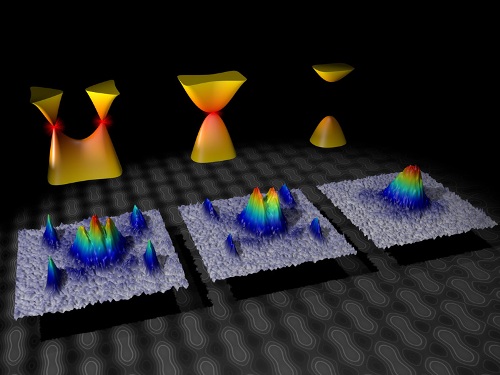A research team led by Tilman Esslinger from the Institute of Quantum Electronics at ETH Zurich is one of the two groups to successfully simulate graphene in experiments. This technique will help understand the consequences caused by the modification of nanomaterial’s lattice structure.
 The density distribution of the potassium atoms measured after acceleration through Dirac points (left and centre), and without Dirac point (right). The upper row shows the corresponding regions of the calculated bandstructure. (Image: Tilman Esslinger’s Research Group / ETH Zurich)
The density distribution of the potassium atoms measured after acceleration through Dirac points (left and centre), and without Dirac point (right). The upper row shows the corresponding regions of the calculated bandstructure. (Image: Tilman Esslinger’s Research Group / ETH Zurich)
The study findings have been reported in the research journal, Nature. Esslinger’s team introduced ultracold potassium atoms into a novel lattice structure created by a laser light. The team utilized a set of orthogonal and accurately placed laser beams to form various 2D light field geometries that include graphene’s honeycomb lattice structure.
During the study, the research team brought the potassium atoms to rest by cooling them in a vacuum chamber at temperatures slightly higher than absolute zero. The team then placed the optical lattice on the cloud of atoms. Controlling the laser beams accurately was a major challenge for the team.
Following their arrest inside the optical lattice, the potassium atoms started to act like electrons in graphene’s crystal structure. The research team was able to find Dirac points in the optical lattice when the potassium atoms were accelerated by a magnetic field gradient. The atoms act like zero-mass particles close to Dirac point, same as electrons’ behavior in graphene. They were able to shift towards the conduction band from the valence band as the band gap disappears. The research team then turned off the laser beams to eliminate the optical honeycomb lattice, causing the atoms to flow via the vacuum. The team then captured the atomic distribution’s absorption image in order to reconstruct the trajectories of the atoms. The researchers also discovered that the atoms can gain their mass back when the lattice symmetry is slightly altered.
Esslinger believes that this method is useful in simulating electronic properties of future materials well before their physical realization and will be helpful in novel material search.
Source: http://www.ethz.ch/